window TOYOTA COROLLA 2009 10.G Owners Manual
[x] Cancel search | Manufacturer: TOYOTA, Model Year: 2009, Model line: COROLLA, Model: TOYOTA COROLLA 2009 10.GPages: 468, PDF Size: 9.31 MB
Page 2 of 468

TABLE OF CONTENTSIndex
2
1-1. Key information .................. 20Keys ..................................... 20
1-2. Opening, closing and
locking the doors and
trunk .................................. 22
Smart key system................. 22
Wireless remote control ....... 34
Doors.................................... 38
Trunk .................................... 43
1-3. Adjustable components
(seats, mirrors,
steering wheel) ................. 46
Front seats ........................... 46
Rear seats ............................ 49
Head restraints ..................... 51
Seat belts ............................. 53
Steering wheel ..................... 61
Anti-glare inside rear view mirror .................................. 62
Outside rear view mirrors ..... 64
1-4. Opening a nd closing the
window s ............................ 66
Power windows .................... 66
Moon roof ............................. 68
1-5. Refueling ............................. 71 Opening the fuel tank cap .... 71 1-6. Theft deterrent system ....... 75
Engine immobilizer system ................................ 75
Theft prevention labels (for U.S.A.) ......................... 77
1-7. Safety information .............. 78 Correct driving posture ......... 78
SRS airbags ......................... 80
Front passenger occupant classification system ........... 92
Child restraint systems ......... 97
Installing child restraints ..... 101
2-1. Driving procedures........... 112 Driving the vehicle .............. 112
Engine (ignition) switch (vehicles with smart
key system) ...................... 122
Engine (ignition) switch (vehicles without smart
key system) ...................... 126
Automatic transmission ...... 130
Manual transmission........... 135
Turn signal lever ................. 136
Parking brake ..................... 137
2-2. Instrument cluster ............ 138 Gauges and meters ............ 138
Indicators and warning lights ................................. 142
Multi-information display ..... 146
1Before driving
2When driving
Page 3 of 468

1
2
3
4
5
6
7
3
2-3. Operating the lights and wipers .............................. 150
Headlight switch .................. 150
Fog light switch ................... 152
Windshield wipers and washer .............................. 153
2-4. Using other driving systems ........................... 155
Cruise control ...................... 155
Driving assist systems ........ 158
2-5. Driving information ........... 162 Cargo and luggage ............. 162
Vehicle load limits ............... 165
Winter driving tips ............... 166
Trailer towing ...................... 170
Dinghy towing (automatic
transmission) .................... 178
Dinghy towing (manual transmission) ...... 179
3-1. Using the air conditioning system
and defogger ................... 184
Automatic air conditioning system .......... 184
Manual air conditioning system .......... 190
Rear window and outside rear view mirror
defoggers .......................... 197 3-2. Using the audio system ... 198
Audio system types ............ 198
Using the radio ................... 201
Using the CD player ........... 207
Playing MP3 and WMA discs ....................... 214
Optimal use of the audio system .............................. 222
Using the AUX adapter....... 224
Using the steering wheel audio switches.................. 225
3-3. Using the hands-free phone system
(for cellular phone)......... 228
Hands-free phone system (for cellular phone)
features ............................ 228
Using the hands-free phone system
(for cellular phone) ........... 231
Making a phone call ........... 240
Setting a cellular phone ...... 244
Security and system setup ................................ 249
Using the phone book ........ 253
3-4. Using the interior lights ... 260 Interior lights list ................. 260
• Interior light ...................... 262
• Personal lights.................. 262
• Personal/interior lights...... 263
3Interior features
Page 8 of 468
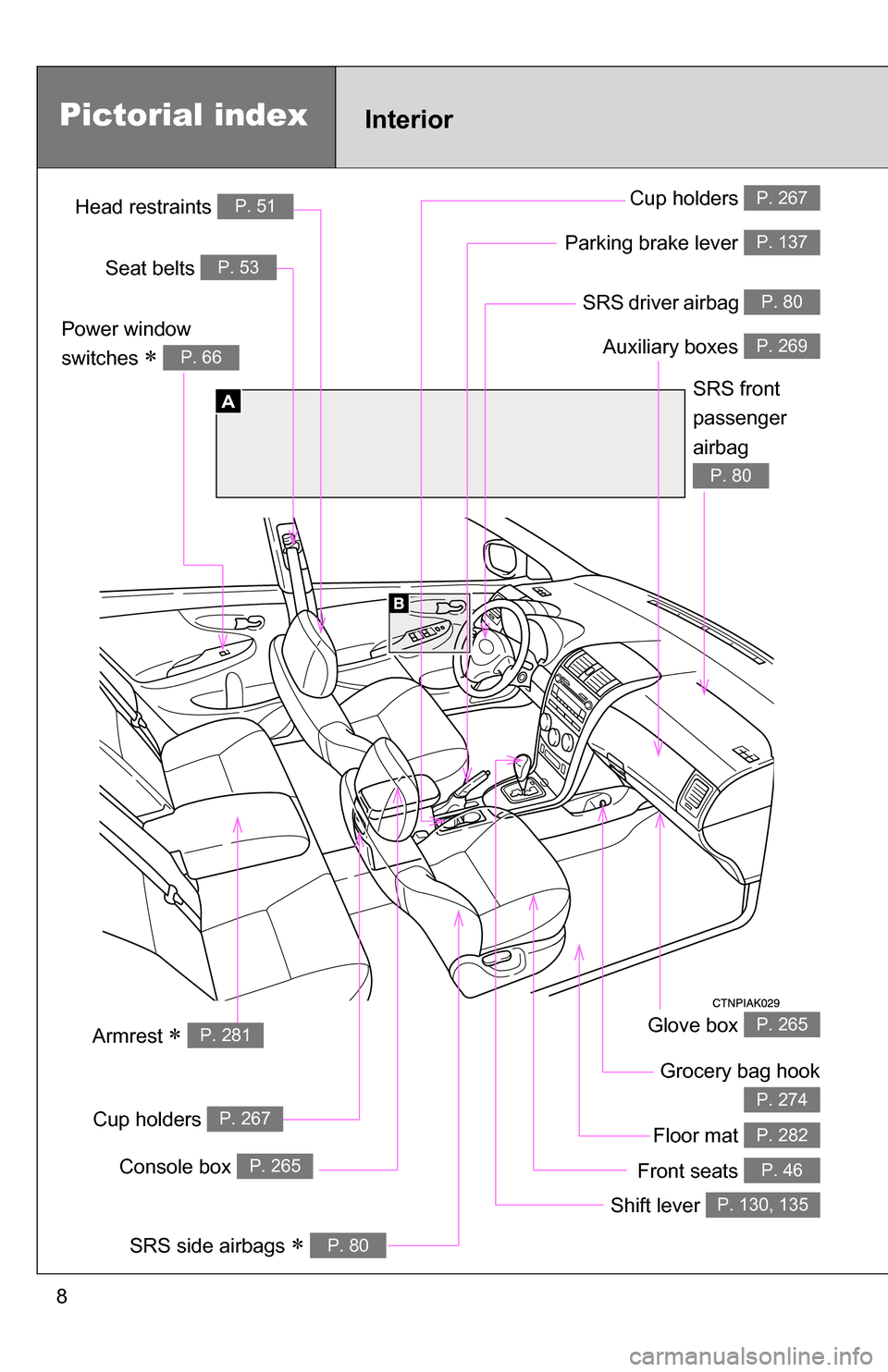
8
Glove box P. 265
Grocery bag hook
P. 274
SRS side airbags P. 80
Power window
switches
P. 66
SRS front
passenger
airbag
P. 80
SRS driver airbag P. 80
A
Console box P. 265
InteriorPictorial index
Floor mat P. 282
Head restraints P. 51
Armrest P. 281
Seat belts P. 53
Auxiliary boxes P. 269
Parking brake lever P. 137
Shift lever P. 130, 135
Front seats P. 46
Cup holders P. 267
Cup holders P. 267
Page 9 of 468
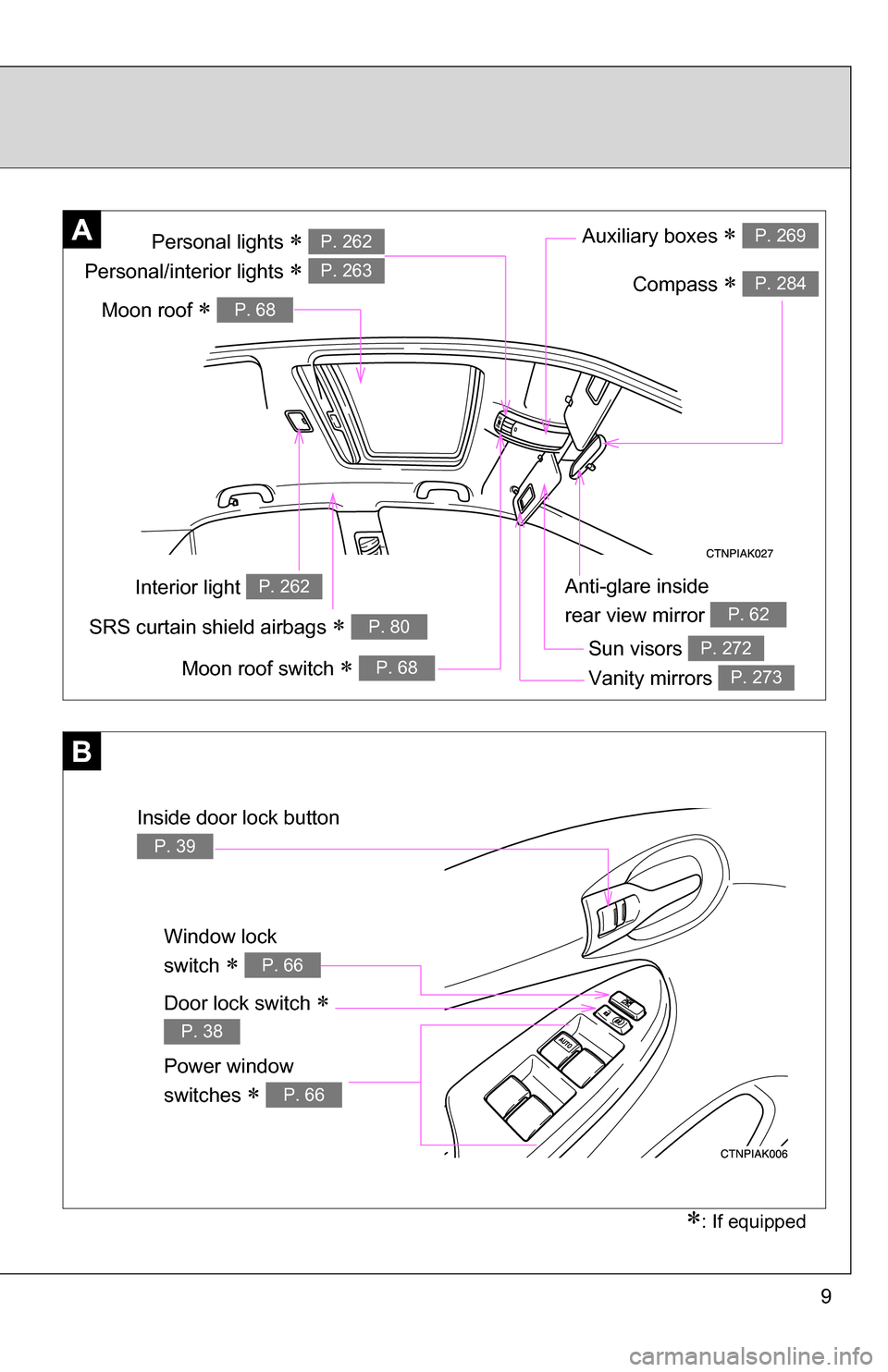
9
Anti-glare inside
rear view mirror
P. 62
Interior light P. 262
Personal lights
Personal/interior lights
P. 262
P. 263
SRS curtain shield airbags P. 80
A
: If equipped
Sun visors P. 272
Vanity mirrors P. 273
Auxiliary boxes P. 269
Window lock
switch
P. 66
Power window
switches
P. 66
B
Door lock switch
P. 38
Inside door lock button
P. 39
Compass P. 284
Moon roof switch P. 68
Moon roof P. 68
Page 11 of 468
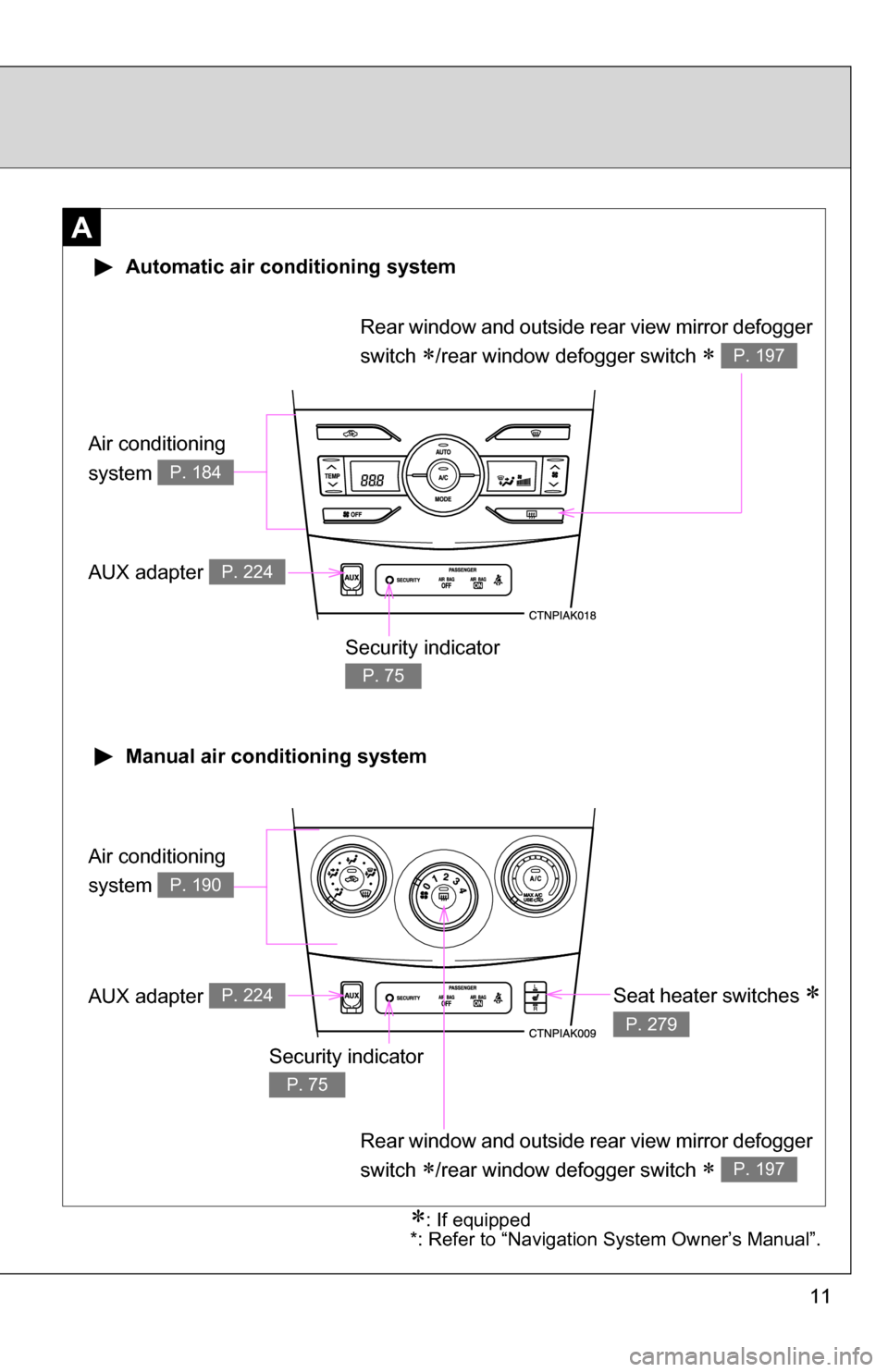
11
A
Air conditioning
system
P. 184
Air conditioning
system
P. 190
Automatic air conditioning system
Manual air conditioning system
Security indicator
P. 75
Seat heater switches
P. 279
AUX adapter P. 224
AUX adapter P. 224
: If equipped
*: Refer to “Navigation System Owner’s Manual”.
Rear window and outside rear view mirror defogger
switch
/rear window defogger switch P. 197
Rear window and outside rear view mirror defogger
switch
/rear window defogger switch P. 197
Security indicator
P. 75
Page 16 of 468

16
CAUTION
■General precautions while driving
Driving under the influence: Never drive your vehicle when under the influ-
ence of alcohol or drugs that have impaired your ability to operate your vehi-
cle. Alcohol and certain drugs delay reaction time, impair judgment and
reduce coordination, which could lead to an accident that will hurt or kill you,
your occupants or others.
Defensive driving: Always drive defensively. Anticipate mistakes that other
drivers or pedestrians might make and be ready to avoid accidents.
Driver distraction: Always give your full attention to driving. Anything that dis-
tracts the driver, such as adjusting controls, talking on a cellular phone or
reading can result in a collision with resulting death or serious injury to you,
your occupants or others.
■ General precaution regarding children’s safety
Never leave children unattended in the vehicle, and never allow children to
have or use the key.
Children may be able to start the vehicle or shift the vehicle into neutral.
There is also a danger that children may injure themselves by playing with
the cigarette lighter, the windows, or other features of the vehicle. In addi-
tion, heat build-up or extremely cold temperatures inside the vehicle can be
fatal to children.
Page 19 of 468
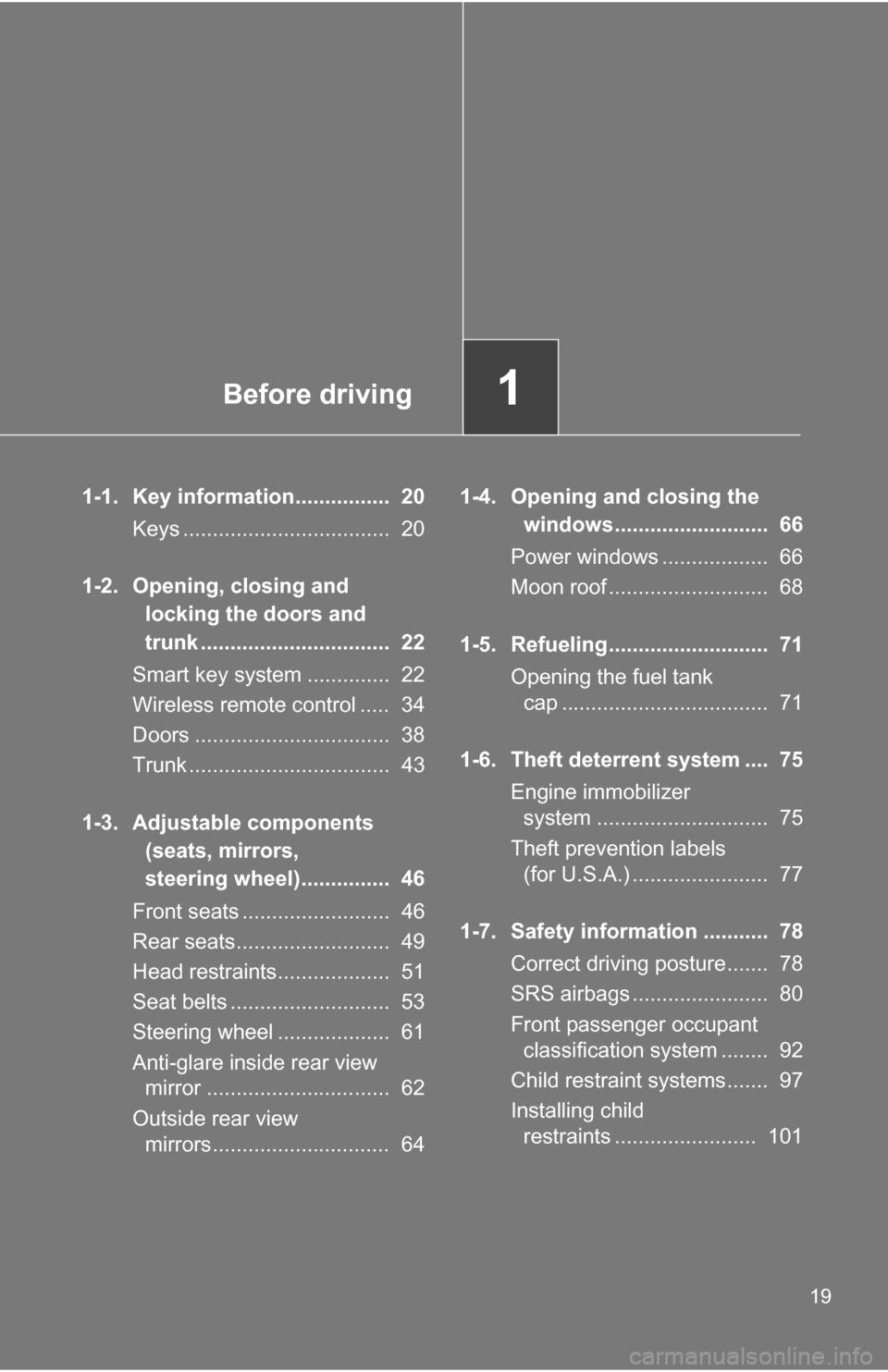
Before driving1
19
1-1. Key information................ 20Keys ................................... 20
1-2. Opening, closing and locking the doors and
trunk ................................ 22
Smart key system .............. 22
Wireless remote control ..... 34
Doors ................................. 38
Trunk .................................. 43
1-3. Adjustable components (seats, mirrors,
steering wheel)............... 46
Front seats ......................... 46
Rear seats.......................... 49
Head restraints................... 51
Seat belts ........................... 53
Steering wheel ................... 61
Anti-glare inside rear view mirror ............................... 62
Outside rear view mirrors.............................. 64 1-4. Opening and closing the
windows.......................... 66
Power windows .................. 66
Moon roof ........................... 68
1-5. Refueling........................... 71 Opening the fuel tank cap ................................... 71
1-6. Theft deterrent system .... 75 Engine immobilizer system ............................. 75
Theft prevention labels (for U.S.A.) ....................... 77
1-7. Safety information ........... 78 Correct driving posture....... 78
SRS airbags ....................... 80
Front passenger occupant classification system ........ 92
Child restraint systems....... 97
Installing child restraints ........................ 101
Page 26 of 468
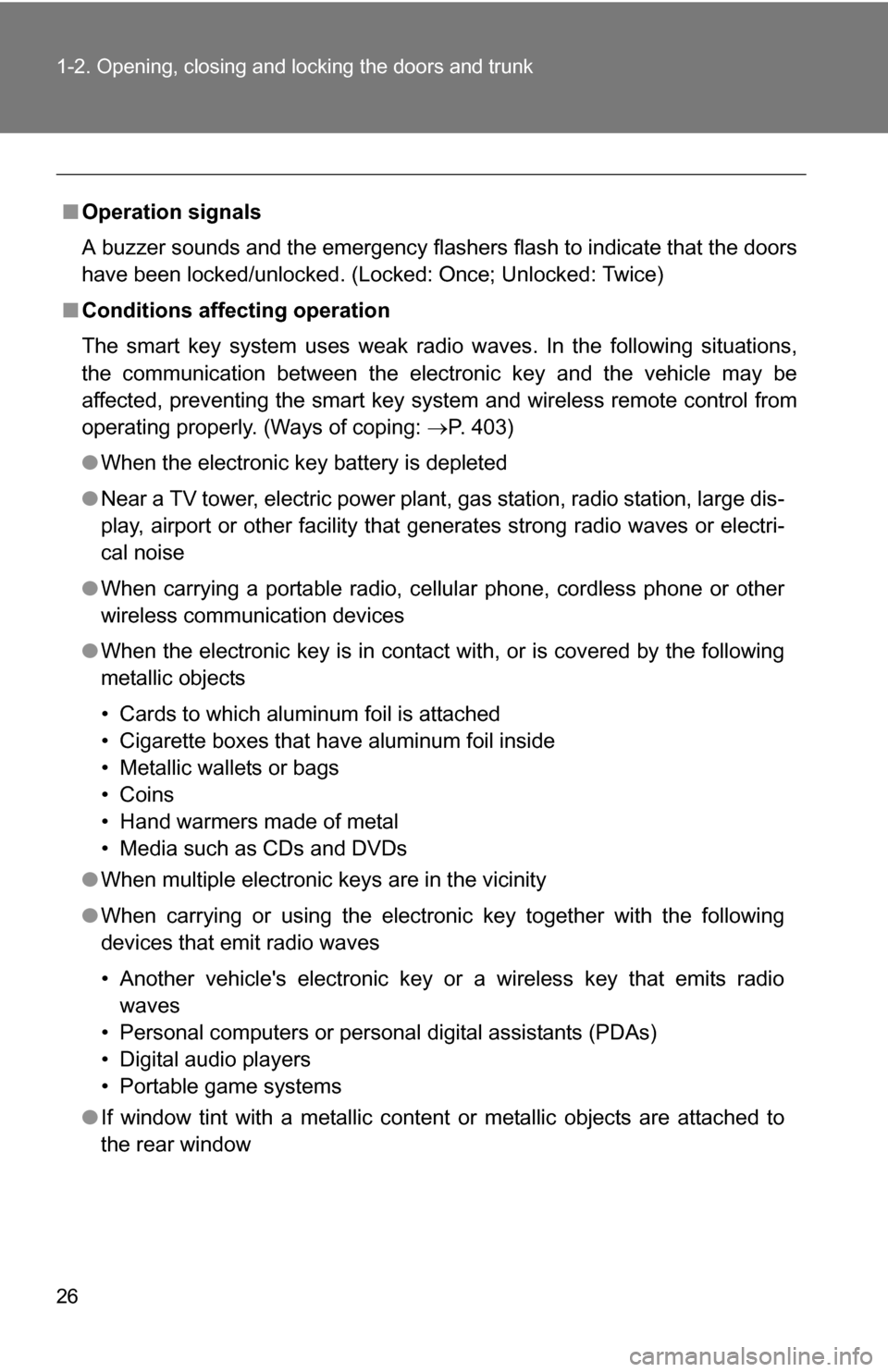
26 1-2. Opening, closing and locking the doors and trunk
■Operation signals
A buzzer sounds and the emergency flashers flash to indicate that the doors
have been locked/unlocked. (Locked: Once; Unlocked: Twice)
■ Conditions affecting operation
The smart key system uses weak radio waves. In the following situations,
the communication between the electronic key and the vehicle may be
affected, preventing the smart key system and wireless remote control from
operating properly. (Ways of coping: P. 403)
● When the electronic key battery is depleted
● Near a TV tower, electric power plant, gas station, radio station, large dis-
play, airport or other facility that generates strong radio waves or electri-
cal noise
● When carrying a portable radio, ce llular phone, cordless phone or other
wireless communication devices
● When the electronic key is in contact with, or is covered by the following
metallic objects
• Cards to which aluminum foil is attached
• Cigarette boxes that have aluminum foil inside
• Metallic wallets or bags
• Coins
• Hand warmers made of metal
• Media such as CDs and DVDs
● When multiple electronic keys are in the vicinity
● When carrying or using the electronic key together with the following
devices that emit radio waves
• Another vehicle's electronic key or a wireless key that emits radio
waves
• Personal computers or personal digital assistants (PDAs)
• Digital audio players
• Portable game systems
● If window tint with a metallic content or metallic objects are attached to
the rear window
Page 28 of 468

28 1-2. Opening, closing and locking the doors and trunk
■Electronic key battery depletion
●The standard battery life is 1 to 2 years.
● The battery becomes depleted even if the electronic key is not used
because the key always transmits radio waves. If the smart key system
or the wireless remote control function does not operate, or the detection
area becomes smaller, the battery may be depleted. Replace the battery
when necessary. ( P. 343)
● To avoid serious deterioration, do not leave the electronic key within 3 ft.
(1 m) of the following electrical appliances that produce a magnetic field:
•TVs
• Personal computers
• Recharging cellular phones or cordless phones
• Table lamps
■ To operate the system properly
Make sure to carry the electronic key when operating the system. Do not get
the electronic key too close to the vehicle when operating the system from
the outside of the vehicle.
Depending on the position and holding condition of the electronic key, the
key may not be detected correctly and the system may not operate properly.
(The alarm may go off accidentally, or the door lock prevention may not func-
tion.)
■ Note for the smart key system
●Even when the electronic key is within the effective range (detection
areas), the system may not operate properly in the following cases.
• The electronic key is too close to the window or outside door handle,
near the ground, or in a high place when the doors are locked or
unlocked.
• The electronic key is near the ground or in a high place, or too close to the rear bumper center when the trunk is unlocked.
• The electronic key is on the instrument panel, package tray, floor, or in the auxiliary box of the driver's side instrument panel or glove box
when the engine is started or “ENGINE START STOP” switch modes
are changed.
● As long as the electronic key is within the effective range, the doors may
be locked or unlocked by anyone.
Page 29 of 468

29
1-2. Opening, closing and locking the doors and trunk
1
Before driving
●
Even if the electronic key is not inside the vehicle, it may be possible to
start the engine if the electronic key is near the window.
● The doors may unlock if a large amount of water splashes on the door
handle, such as in the rain or in a car wash. (The doors will automatically
be locked after approximately 60 seconds if the doors are not opened
and closed.)
● Gripping the door handle when wearing a glove may not unlock the door.
● If the wireless remote control is used to lock the doors when the elec-
tronic key is near the vehicle, there is a possibility that the door may not
be unlocked by the entry function. (Use the wireless remote control to
unlock the doors.)
● A sudden approach to the effective range or door handle may prevent the
doors from being unlocked. In this case, return the door handle to the
original position and check that the doors unlock before pulling the door
handle again.
■ When the vehicle is not dr iven for extended periods
To prevent theft of the vehicle, do not leave the electronic key within 6 ft. (2
m) of the vehicle.
■ Security feature
If a door is not opened within approximately 60 seconds after the vehicle is
unlocked, the security feature automatically locks the vehicle again.
■ Alarms and warning indicators
A combination of exterior and interior alarms as well as warning lights are
used to reduce the chance of vehicle theft and accidents resulting from erro-
neous operation.
●When any warning lights come on:
Take appropriate measures according to which warning light comes on.
( P. 377)